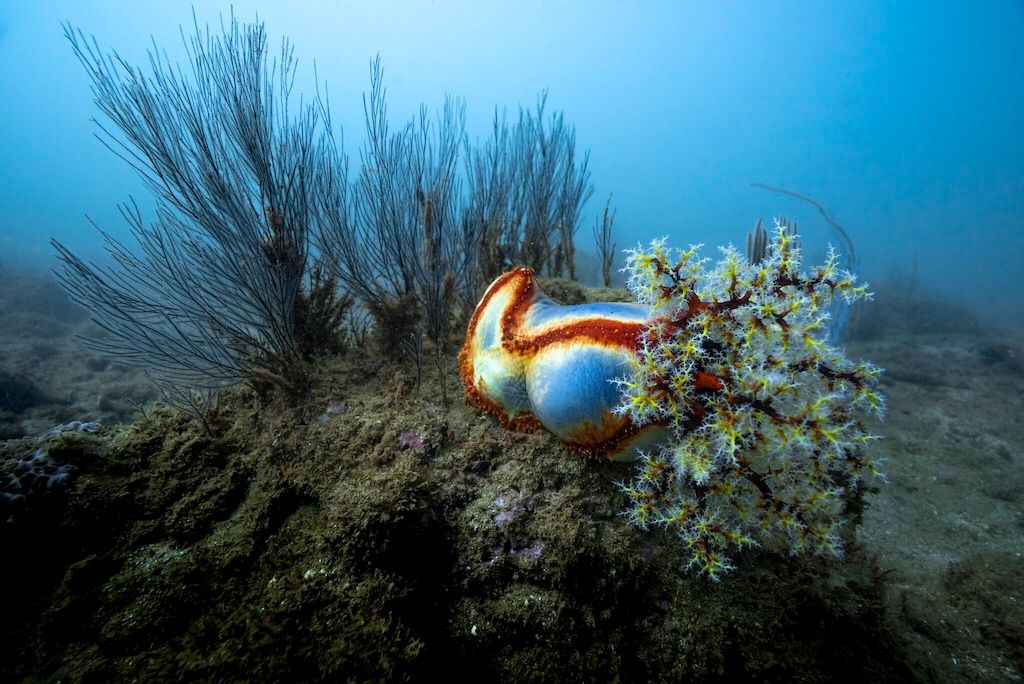Soft coral species and a sea apple at an unsurveyed site in Exmouth Gulf. The extensive, sheltered waters of the gulf and its variety of ecosystems are home to an exceptionally high level of biodiversity. Photos: Rolex/Tom Cannon
A spectacular wilderness which is home to nearly 2,000 species of fauna, the Exmouth Gulf and Ningaloo Coast World Heritage Area’s varied habitats include nutrient-giving salt flats, seagrass beds, macro-algal reefs, hard corals and filter-feeder-dominated seabeds, which support a wealth of biodiversity.
This marine paradise – where part of the world’s largest population of humpback whale mothers congregate to nurse their young – was recognised as a Hope Spot by legendary oceanographer Sylvia Earle’s non-profit Mission Blue network in 2019, thanks to the lifelong commitment of marine biologist Ben Fitzpatrick to the ocean.
Since 2014, Rolex has partnered with Mission Blue, as part of the company’s Perpetual Planet Initiative, to protect and preserve ecologically important areas of the oceans.
Fitzpatrick applied for Exmouth Gulf and Ningaloo Coast to become a Hope Spot to show how important it is to the reef’s survival.
Hope Spots are places that are scientifically identified as critical to the health of the ocean, areas championed by local conservationists whom Mission Blue supports with communications, expeditions and scientific advisory.
Ningaloo’s nursery
The west coast sister to the Great Barrier Reef, Ningaloo Reef is one of Australia’s most significant marine Unesco World Heritage sites, and lying just around the corner of the reef’s peninsula are the quiet waters of Exmouth Gulf.
Known as “Ningaloo’s nursery” because so many of the reef’s endangered species shelter there when young, the coast of the sheltered bay is lined with a unique arid-zone mangrove system.
Humpback whales stop in the gulf on their long migration to Antarctica to nurse their calves, with the newborns doubling in size during their time there.
Free from threats since the end of Australian whaling, this population has proliferated in recent years, going from just 300 to over 30,000 according to Fitzpatrick.
“Most of the time the gulf is quite murky and inaccessible, so people don’t realise that below the surface are some of the most incredible and unique marine ecosystems on the planet. It needs protection. The environment speaks for itself, and all I’m doing is providing a voice,” said Fitzpatrick.
Tourists travel from all corners of the globe to experience the area’s rich biodiversity, swim in the fringing coral reef and spot whale sharks, humpback whales, manta rays, dolphins, dugongs, sea snakes, sharks and turtles.
Despite making up two sides of one deeply interconnected ecosystem, the gulf is only now beginning to enjoy some of the same recognition – and subsequent protection – as the reef.
Protecting a unique gulf
Fitzpatrick has been captivated by Ningaloo Coast and Exmouth Gulf since he was six years old, when his grandfather used to tell him stories about “amazing things, like whale sharks, dugong and spawning coral.”
These stories captured his imagination so vividly he pursued a career as a marine scientist, and has been dedicated to protecting the region ever since.
In 2003, he was part of a public campaign that saved Ningaloo Coast from development and cemented it as a place of great value globally.
Fitzpatrick has recently undertaken a scientific expedition to Exmouth Gulf – still largely unmapped and undiscovered – to collect evidence of its biodiversity and connection to Ningaloo Coast.
Surveying the gulf from the air and below the water’s surface, he hopes to highlight that the world-famous wildlife of Ningaloo Coast is both complimented by and dependent on the health and function of Exmouth Gulf.
Fitzpatrick and his team hope to strengthen the case for expanding the protection around this haven for marine life with the support of the Rolex Perpetual Planet Initiative.
The Perpetual Planet Initiative
For nearly a century, Rolex has supported pioneering explorers pushing back the boundaries of human endeavour. The company has moved from championing exploration for the sake of discovery to protecting the planet, committing for the long term to support individuals and organisations using science to understand and devise solutions to today’s environmental challenges.
This engagement was reinforced with the launch of the Perpetual Planet Initiative in 2019, which initially focused on the Rolex Awards for Enterprise, as well as longstanding partnerships with Mission Blue and National Geographic Society.
The Initiative now has more than 30 other partnerships in an expanding portfolio focusing in ocean conservation, wilderness protection and the preservation of the living world.
These partnerships include: Cristina Mittermeier and Paul Nicklen; the Under The Pole expeditions; the Monaco Blue Initiative; Coral Gardeners; Rewilding Argentina and Rewilding Chile, offspring organisations of Tompkins Conservation; and many Rolex Award for Enterprise Laureates.Rolex also supports future generations of explorers, scientists and conservationists through education with scholarships and grants, such as Our World-Underwater Scholarship Society and The Rolex Explorers Club Grants.










